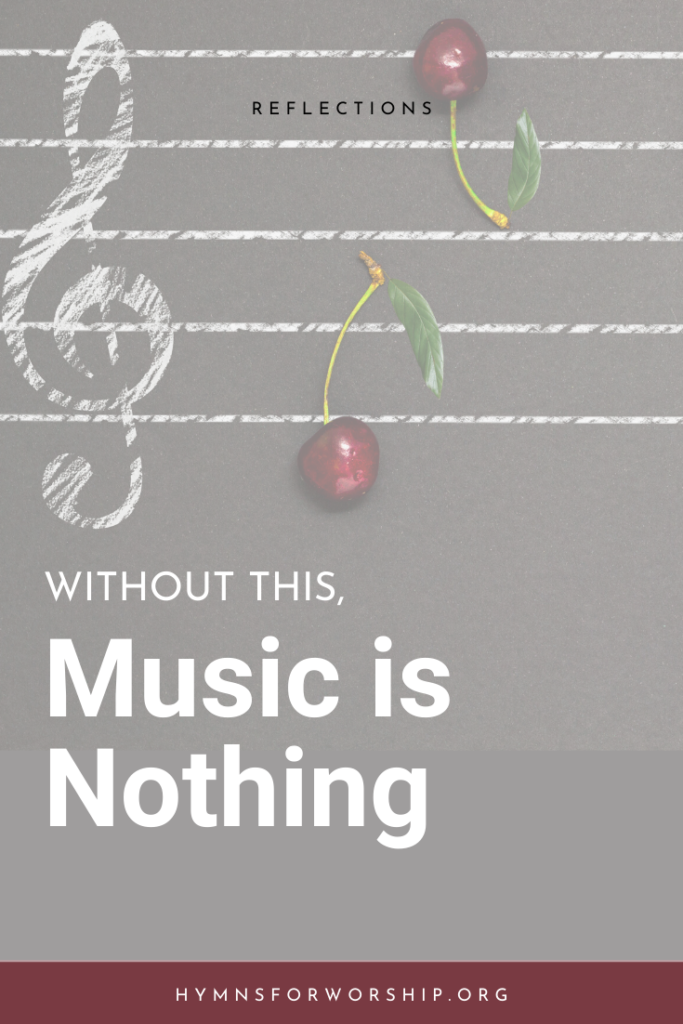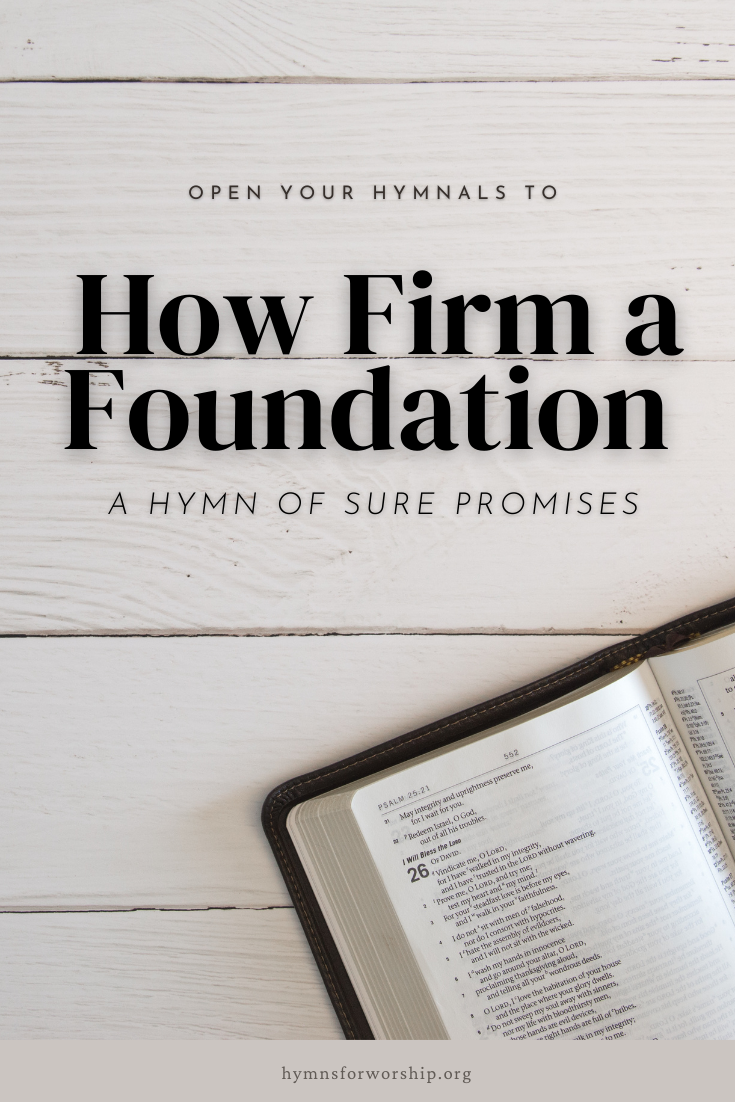
“The great architect Frank Lloyd Wright was given the challenge of building the Imperial Hotel in Tokyo, one of the most earthquake-prone cities in the world. Wright’s investigation showed that a solid foundation could be “floated” on a sixty-foot layer of soft mud underlying the hotel, which would provide a shock-absorbing but solid support for the immense building. Shortly after the hotel was completed it withstood the worst earthquake in fifty-two years, while smaller buildings fell in ruins around it.” (Today in the Word, March 1989, p. 6)
A Christian’s stability in this life, as well as his confidence for eternity rests solely on the written promises of God’s Word. The direction of the living God for our lives is very definite. It is found in a firm foundation — the written revelation: “Thus saith the Lord.”
Text authorship
This hymn in enshrouded in mystery, in that both the text author and tune composer are unknown. We can only trace the text back to its first publication in 1787, in a hymnal called A Selection of Hymns from the best authors, intended as an appendix to Dr Watts’s Psalms and Hymns. Put together by John Rippon who is a Baptist pastor, this hymnal was an important contribution to hymnody, and became the most popular Baptist hymnbook in England and North America for many years.
Rippon’s hymnal included 7 stanzas of this hymn and was originally entitled ‘Exceeding great and precious Promises. 2 Pet. 3: 4.’ The Bible text was later amended to 2 Pet. 1:4 in the 1790 edition, which is believed to be the correct reference
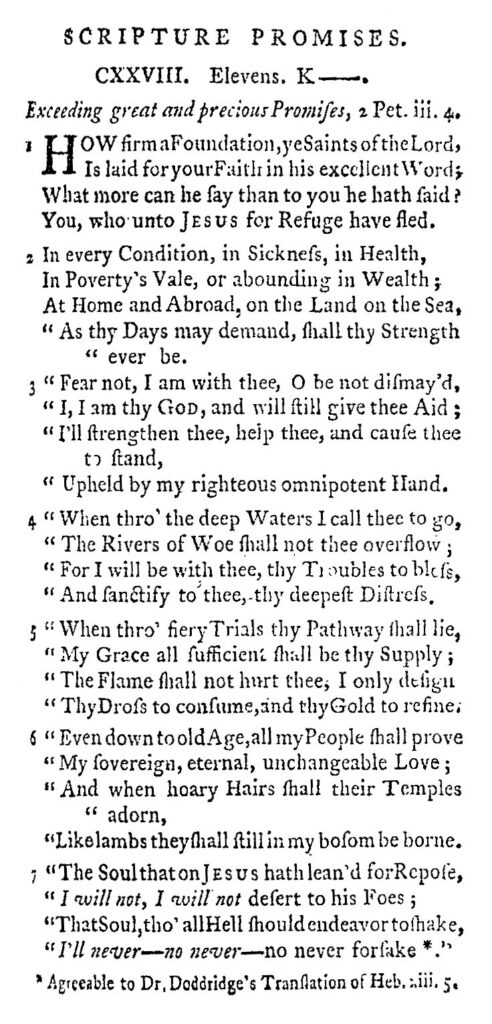

The original title of this hymn could not have been more precise. Whoever the author was (it was only initialed K who is speculated to be a certain Robert Keen or George Keith), he certainly filled every stanza reminders of God’s exceeding great and precious promises.
Biblical inspiration behind the text
“Whereby are given unto us exceeding great and precious promises: that by these ye might be partakers of the divine nature, having escaped the corruption that is in the world through lust.” 2 Peter 1: 4
This verse was most probably the inspiration for the hymn as it talks about the abundant promises God is giving to those who are partakers of His divine nature.
The first stanza lays the foundation about the firmness and the unyielding strength of God’s word. In Paul’s speech to the Corinthians, he explains that there is other foundation that no man can lay, except Jesus Christ (1 Corinthians 3:1). Isaiah proclaimed the same thing that God has laid a foundation stone — a tried stone, a precious corner stone, a sure foundation (Isaiah 28:16). Peter acts as a third witness to this metaphor when he wrote, “Wherefore also it is contained in the scripture, ‘Behold I lay in Sion a chief corner stone, elect, precious: and he that believeth on him shall not be confounded.”
Knowing the Jesus is the sure foundation, we can also be sure that this surety extends to His word. The hymn author aptly adds that because of this, we can run to Him and His word for refuge.
The second stanza is a rhyming paraphrase based on Isa 41:10, “Fear thou not; for I am with thee: be not dismayed; for I am thy God: I will strengthen thee; yea I will help thee; yea, I will uphold thee with the right hand of my righteousness.”
Two chapters later, we find the promise mentioned in the 3rd and 4th stanza of the hymn. Isaiah 43:2 says, “When thou passes through the waters, I will be with the; and through rivers, they shall not overflow thee; when thou walkers through the fire, thou shalt not be burned; neither shall the flame kindle upon thee.”
The final stanza finds us in Hebrews 13:5 which says, “Let your conversation be without covetousness; and be content with such things as ye have; for he hath said, I will never leave thee, nor forsake thee.”
In describing this hymn, Albert Edward Bailey said “The hymn is really a sermon in verse.” April Cover expressed the same sentiments by saying it is “an opportunity to reflect on the assurances of God’s steadfast love and sufficient grace for His people.”
Text Origin
We may have been used to 5 stanzas in the SDA Hymnal, but the original actually have 7. For reference’s sake, here’s the original text from the 1790 edition, including the quotation marks.
How firm a foundation, ye saints of the Lord,
Is laid for your faith in his excellent word!
What more can he say that to you he hath said?
You, who unto Jesus for refuge have fled,
In every condition, in sickness, in health,
In poverty’s vale, or abounding in wealth;
At home or abroad, on the land, on the sea,
“As thy days may demand shall thy strength ever be.”
“Fear not, I am with thee, O be not dismay’d,
I, I am thy God, and will soon give thee aid;
I’ll strengthen thee, help thee, and cause thee to stand,
Upheld by my righteous omnipotent hand.”
“When thro’ the deep waters I call thee to go,
The rivers of woe shall not thee overflow;
For I will be with thee, thy troubles to bless,
And sanctify to thee, thy deepest distress.”
“When thro’ fiery trials thy path-way shall lie,
My grace all-sufficient shall be thy supply;
The flame shall not hurt thee, I only design
Thy dross to consume, and thy gold to refine.”
“Even down to old age, all my people shall prove
My sovereign, eternal, unchangeable love;
And when hoary hairs shall their temples adorn,
Like lambs they shall still in my bosom be borne.”
“The soul that on Jesus hath lean’d for repose,
I will not, I will not, desert to his foes;
That soul, tho’ all hell should endeavour to shake,
I’ll never – no never- no never forsake.”
Learn the hymn
Printables, piano accompaniment, hymn text and other tidbits are all available in this site.
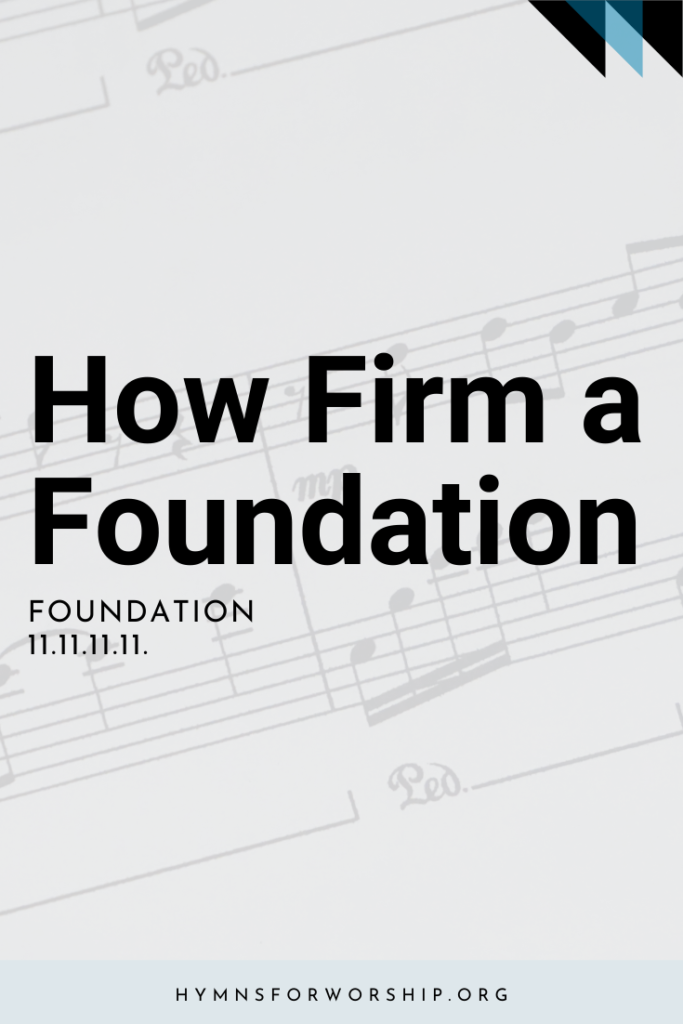
Tune
This hymn has also been partnered to a slew of tunes. BROUGHTON, GEARD and ADESTE FIDELES have been used in many hymnal compilations. But the one that stuck better was PROTECTION also called FOUNDATION. The latter first appeared in A Compilation of Genuine Church Music (1832) edited by Joseph Funk, a German Mennonite who settled in the Shenandoah Valley near Harrisonburg, Virginia.
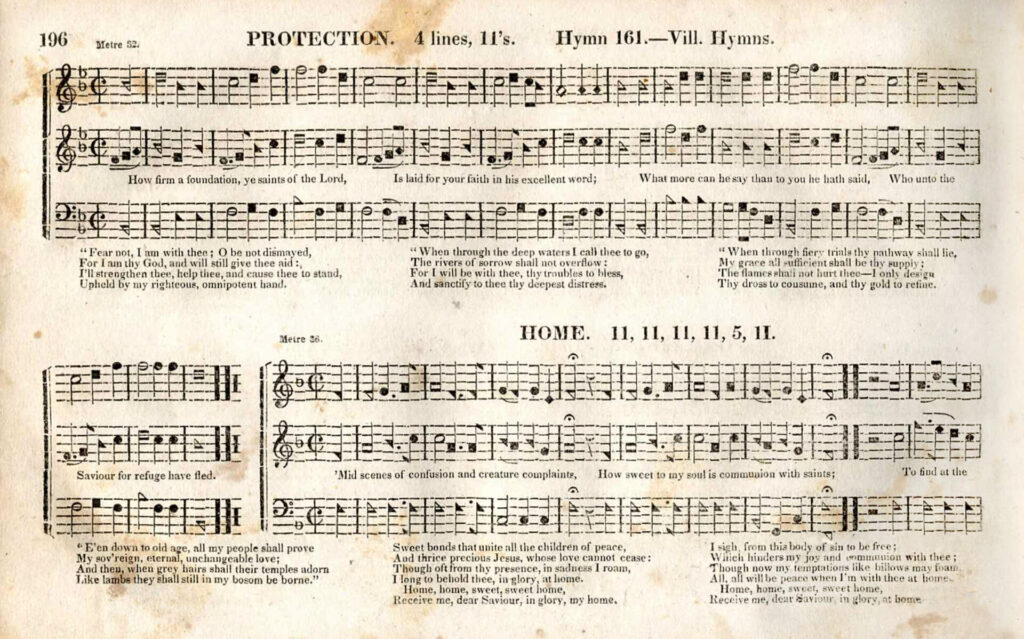
According to hymnologist Carl P. Daw Jr., this pentatonic American tune “has an AA’BA’ structure that makes it easy to learn and remember. The economy of elements is quite remarkable.” The use of consistent rhythm of quarters and halves was, according to Daw, “an effective match for the meter of the text.”
Popularity
The popularity of this hymn is attributed to the fact that it was sung during the funerals of two American presidents, Theodore Roosevelt and Woodrow Wilson. It was a favorite of General Robert E. Lee and also sung at his funeral.
An interesting account of these lyrics bringing comfort – and unity – in times of uncertainty is found in an anecdote from the Spanish-American war. This conflict came about 30 years after the end of the US Civil War, and tensions between the North and the South were still high.
On Christmas Eve, 1898, it was sung by an entire corps of the United States Army encamped near Havana, Cuba. Lieutenant-Colonel Curtis Guild, Jr. related the inspiring story to The Sunday-School Times back in 1901. Guild wrote:
Suddenly from the camp of the Forty-ninth Iowa rang a sentinel’s call, “Number ten; twelve o’clock, and all’s well!” It was Christmas morning. Scarcely had the cry of the sentinel died away, when from the bandsmen’s tents of that same regiment there rose the music of an old, familiar hymn, and one clear baritone voice led the chorus that quickly ran along those moonlit fields: ‘How firm a foundation, ye saints of the Lord!’
Another voice joined in, and another, and another, and in a moment the whole regiment was singing, and then the Sixth Missouri joined in, with the Fourth Virginia, and all the rest, till there, on the long ridges above the great city whence Spanish tyranny once went forth to enslave the New World, a whole American army corps was singing –
Fear not, I am with thee, O be not dismayed;
For I am thy God, and will still give thee aid;
I’ll strengthen thee, help thee and cause thee to stand,
Upheld by My righteous, omnipotent hand.The Northern soldier knew the hymn as one he had learned beside his mother’s knee. To the Southern soldier it was that and something more; it was the favorite hymn of General Robert E. Lee, and was sung at that great commander’s funeral.
Protestant and Catholic, North and South were singing together on Christmas day in the morning – now that’s an American army!
Reasonable Theology, https://reasonabletheology.org/hymn-story-how-firm-a-foundation/
Reflection Questions
How has the Word of God been a firm foundation to you over the past month?
Based on this hymn, what is the author’s attitude toward the Bible? If we share his attitude, how will it show in our lives?
Related Resources
Chris Fenner, “How firm a foundation,” Hymnology Archive (August 2021) https://www.hymnologyarchive.com/how-firm-a-foundation
JRW. “How firm a foundation, ye saints of the Lord.” The Canterbury Dictionary of Hymnology. Canterbury Press. Web. 3 Sep. 2021.<http://www.hymnology.co.uk/h/how-firm-a-foundation,-ye-saints-of-the-lord>
April Brover, “How firm a foundation,” Happy Hymnody (August 2021): https://happyhymnody.wordpress.com/2020/08/01/how-firm-a-foundation-august-2020/



